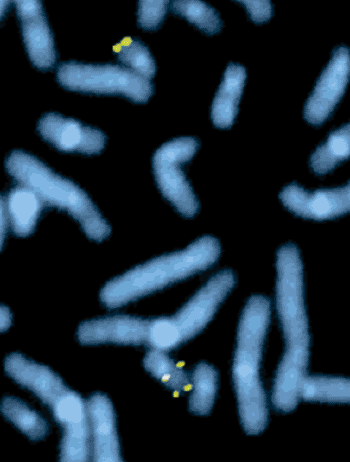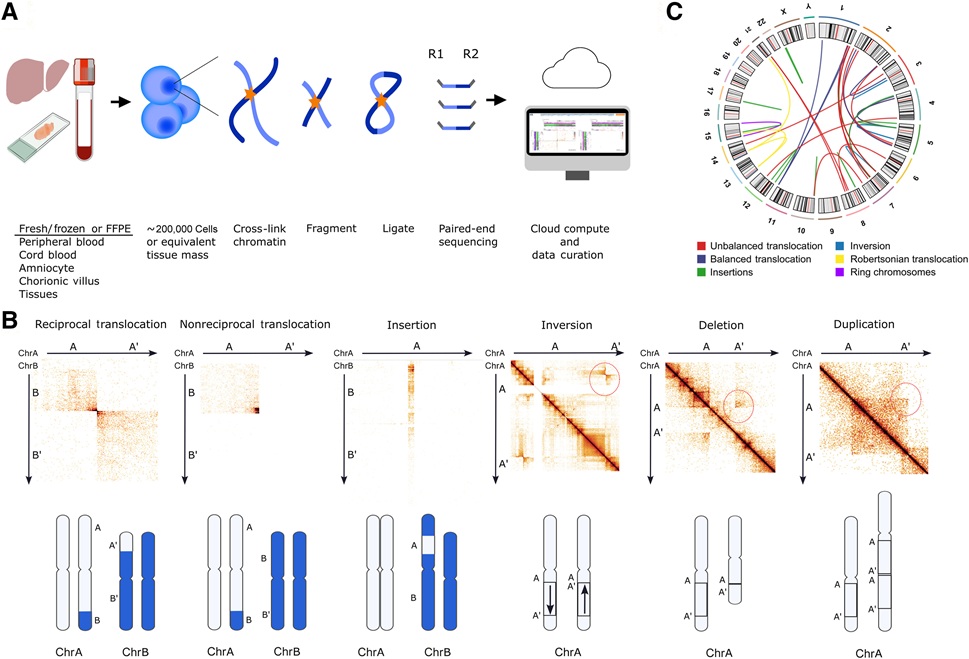Genetic Deletion Linked to Early-Onset Parkinson's Disease
By LabMedica International staff writers
Posted on 25 Sep 2013
A neoteric link has been discovered between early-onset Parkinson's disease (PD) and a microdeletion of a piece of DNA from chromosome 22. Posted on 25 Sep 2013
Among people aged 35 to 64 who were missing DNA from a specific part of chromosome 22, there was a marked increase in the number of cases of PD, compared to expected rates of PD in the general population from the same age group.

Image: Chromosomes imaged with Fluorescence in situ hybridization (FISH) showing a pair of yellow dots as areas of genes are missing due to deleted genes on chromosome 22 (Photo courtesy of Stanford University).
Scientists at the Center for Addiction and Mental Health (Toronto, ON, Canada) studied 159 adults with 22q11.2 deletion syndrome to discover how many had been clinically diagnosed with Parkinson's disease. For three individuals with the deletion and Parkinson's disease who were deceased, brain tissue was also examined. The deletion, which occurs when a person is born with about 50 genes missing on chromosome 22, is associated with 22q11.2 deletion syndrome.
Copy number variations in two 22q11.2 genes encoding for T-box transcription factor (TBX1), and synaptosomal- associated protein, 29 kDa (SNAP29), were examined on a ViiA7 real-time polymerase chain reaction system (Life Technologies; Grand Island, NY, USA). The study found that adults with 22q11.2DS had a significantly elevated occurrence of PD compared with standard population estimates with a standardized morbidity ratio equal to 69.7. All cases showed early onset and typical PD symptom pattern, treatment response, and course. All were negative for family history of PD and known pathogenic PD-related mutations.
The authors concluded that 22q11.2 deletions represent a novel genetic risk factor for early-onset PD with variable neuropathological presentation reminiscent of Leucine-rich repeat kinase 2-associated PD neuropathology. Individuals with early-onset PD and classic features of 22q11.2DS should be considered for genetic testing, and those with a known 22q11.2 deletion should be monitored for the development of parkinsonian symptoms. Molecular studies of the implicated genes, including DiGeorge syndrome critical region gene 8 (DGCR8), may help shed light on the underlying pathophysiology of PD in 22q11.2DS and idiopathic PD.
The team also found that Parkinson's disease in 22q11.2 deletion syndrome is associated with abnormal accumulations of protein called Lewy bodies in the brain in some, but not all cases, just as in another genetic form of Parkinson's disease. Anthony E. Lang, MD, a senior author from the Toronto Western Hospital (ON, Canada) said, “Our discovery that the 22q11.2 deletion syndrome is associated with Parkinson's disease is very exciting. The varying pathology that we found is reminiscent of certain other genetic causes of Parkinson's disease, and opens new directions to search for novel genes that could cause its more common form.” The study was published on September 9, 2103, in the journal JAMA Neurology.
Related Links:
Canadian Centre for Addiction and Mental Health
Life Technologies
Toronto Western Hospital














